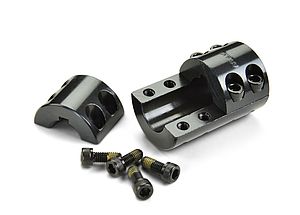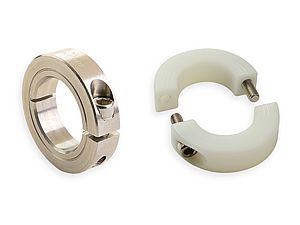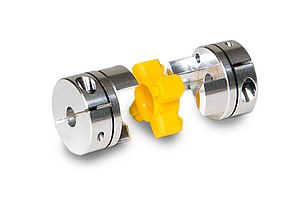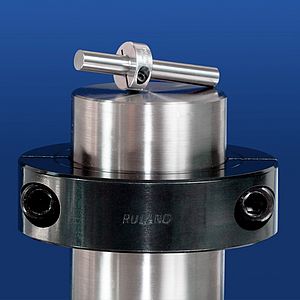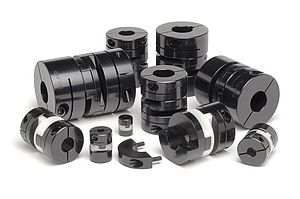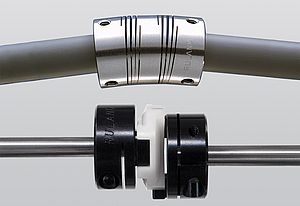Before selecting a coupling, it is helpful to know the specifics of these issues for the application for which the coupling is to be used. Many different types of servo couplings exist with their own individual strong and weakpoints. This article is designed to introduce end users to the different types of couplings available for servo applications. They help the user select the proper coupling for their application, by highlighting the factors that should be considered in the decision making process and how they relate to the different product offerings available.
Beam Couplings
Beam type couplings are manufactured from a single piece of material, usually aluminum, and utilize a system of spiral cuts to accommodate misalignment and transmit torque. For many applications, beam couplings are a good place to start. They generally have good performance characteristics and are aneconomical choice. The single piece design allows the coupling to transmit torque with zero backlash and no maintenance required.
Two basic variations on this theme exist: a single beam style and a multiple beam style.The single beam style has one long continuous cut that usually consists of multiple complete rotations. This results in a coupling that is very flexible and yields light bearing loads. It is able to accommodate all types of misalignment, but works best with angular misalignment or axial motion. Parallel misalignment capabilities are reduced because the single beam is required to bend in two different directions at the same time, creating larger stresses in the coupling that could cause premature failure. Although the long single beam allows the coupling to bend easily under misalignment conditions, it has the same affect on the rigidity of the coupling under torsional loads. The relatively large amount of wind up under torsional loads adversely affects the accuracy of the coupling and reduces its overall performance. Single beam couplings are an economical option that are best utilized in lower torque application, especially in connections to encoders and other light instrumentation.
Multiple beam couplings, which usually consist of 2 or 3 overlapping beams, attack the problem of low torsional rigidity. The use of multiple beams allows for the beams to be shorter without sacrificing much of the misalignment capabilities. The shorter beams make the coupling stiffer torsionally and overlapping them so the beams work in parallel increases the allowable maximum torque making them suitable for use in light duty applications with connections such as from a servo to a leadscrew. This increase inperformance does not come without penalty: bearing loads are increased by a sizeable amount over the single beam variety but, in most cases, remain low enough to protect bearings effectively. Some manufacturers take the multiple beam concept to another level. Instead of having a single set of multiple cuts, two sets of multiple cuts are utilized. The use of multiple sets of cuts gives the coupling additional flexibility and misalignment capability. It also adds a dimension to the misalignment capability of this type of coupling by more readily accepting parallelmis alignment. In contrast to couplings with one beam or a single set of beams, under parallel misalignment, one set of beams bends in one direction and the second set bends in the other direction, making the coupling more adaptable to this type of misalignment.
Most commonly, aluminum versions of these couplings are used. However, several manufacturers offer designs available in stainless steel also. The use of stainless steel, in addition to corrosion protection, also increases the torque capacity and stiffness of the coupling to sometimes double that of aluminum parts of the same design. The increase in torque and stiffness is offset by a dramatic increase in mass and inertia. Often times the negative affects will outweigh the positives and force the user to look for another type of coupling. In applications using smaller motors, a large percentage of the motor’s torque is used to overcome the inertia of the coupling, seriously reducing the performance of the system.
Oldham Couplings
The Oldham coupling is a three piece coupling comprised of two hubs and a center member. The center disk, which is usually made of a plastic or, less commonly, a metallic material, is the torque transmitting element. Torque transmission is accomplished by mating slots in the center disk, located on opposite sides of the disk and oriented 90 degrees apart, with drive tenons on the hubs. The slots of the disk fit on the tenons of the hub with a slight press fit. This press fit allows the coupling to operate with zero backlash. Over time, it should be noted that the sliding of the disk over the tenons will create wear to the point where the coupling will cease to be zero backlash. The disks, however, are inexpensive items that are easily replaced and a new insert will restore the coupling’s original performance.
In operation, the center element slides on the tenon of the hub to accommodate misalignment. Because the only resistance to misalignment is the frictional force between the hub and disk, Oldham couplings have bearing loads that do not increase as misalignment increases. Unlike other types of couplings, there are not any bending members, which act as springs, causing bearing loads to increase as the shafts become further misaligned. This type of coupling will only allow a small amount of angular misalignment (< 1/2 degree) and axial motion (< 0.127mm) and is limited to speeds of 4000rpm. Larger amounts of angular misalignment cause the coupling to lose its constant velocity characteristic, and axial motion is limited by the three piece design of the coupling, which does not allow for use in push-pull types of applications. Also, because the center disk is a floating member, both shafts must be supported to keep the coupling from falling apart.
The area where this design is particularly well suited is handling relatively large amounts of parallel misalignment. Coupling manufacturers generally provide smaller misalignment ratings that allow users to obtain maximum life. However, these ratings can be surpassed at the expense of coupling life. The ability to choose different disk materials is an advantage of this type of coupling. Generally, one material is best used where zero backlash, high torsional stiffness and torque are required, and another material for applications that have less precise positioning requirements, do not require zero backlash, and can benefit from a coupling that can absorb some vibration and reduce noise. Nonmetallic inserts are also electrically isolating and can act as a mechanical fuse. When the plastic insert fails, it breaks cleanly and does not allow any transmission of power, preventing other damage from occurring to more expensiv emachinery components.
Zero Backlash Jaw Couplings
There are two general types of jaw couplings: the conventional straight jaw couplings and curved jaw zero backlash jaw couplings. Conventional straight jaw couplings are not typically well suited to servo applicationswhere accuracy of torque transmission is required. Zero backlash jaw couplings area variation on the same theme, but the differences in design make them well suited to servo applications. The curved jaws help to reduce deformation of the spider and limit the effects of centrifugal forces during high speed operation.
Zero backlash jaw couplings consist of two metallic hubs and an elastomer insert, which is commonly referred to in the industry as a ‘spider’. The spider is a multiple lobed insert that fits between the drive jaws on the coupling hubs with a jaw from each hub fitted alternately between the lobes of the spider. As in the oldham coupling, there is a press fit between the jaws and the spider that allow the coupling to remain zero backlash. In contrast to the oldham coupling, where the torque disk is in shear under torsion alloads, the jaw coupling’s spider operates in compression. When using a zero backlash jaw coupling the user must be careful not to exceed the manufacturer’s rating for maximum torque with zero backlash, which can be significantly below the physical limitations of the spider. If this occurs, the spider can be compressed so that there is no longer a preload and backlash will occur, possibly without the user noticing until a problem occurs.
Jaw couplings are well balanced and are able to handle high rpm applications very well (manufacturers rate speeds up to 40,000+rpm), but are not able to handle very large amounts of misalignment, especially axial motion. Large amounts of parallel and angular misalignment cause bearing loads that are higher than most other types of servo couplings. Another factor that the user must be aware of is the situation when a jaw coupling fails. If a spider fails, the coupling will not disengage. The jaws from the two hubs will mate similar to teeth on two gears and continue to transmit torque with metal to metal contact which, depending on the application, may be desirable, or could cause problems in the overall system where the coupling is installed. An advantage of the jaw coupling is the ability to mix and match spiders based on the application. Manufacturers of zero backlash jaw couplings offer multiple materials with different hardnesses and temperature capabilities that allow the user to choose exactly the insert that meets the application’s performance criteria.
Disk Couplings
Disk couplings are comprised of, at a minimum, two hubs and a thin metallic or composite disk that is the torque transmitting element. The disk is fastened to the hubs usually with a tight fitting pin that does not allow any play or backlash between the diskand hubs. Some manufacturers offer disk couplings with two disks separated by a rigid center member and attached to a hub at each end. This rigid center member is usually metallic, but plastic versions are available to provide a version of this coupling that is electrically isolating. This results in reduced torque capacity and torsional stiffness as a trade off to gaining the insulating property.
The difference between the two variations is quite similar to the difference between the single beam style coupling and the multiple beam coupling consisting of two sets of cuts. The single disk coupling is not very adept at accommodating parallel misalignment due to the complex bending of the disk that would be required. The two disk style allows each disk to bend in opposite directions to harness the parallel offset. The properties of this type of coupling are similar to that of bellows couplings. In fact the way the couplings transmit torque in general is very similar. The disks are very thin, allowing them to bend easily under misalignment loading which allows the coupling to accept large amounts of misalignment (up to 5 degrees) with some of the lowest bearing loads available in a servo coupling. Torsionally, the disks are very stiff. The disk coupling has stiffness ratings slightly lower than that of bellows couplings. A downside to these couplings is that they are very delicate and prone to damage if misused or installed improperly. Special care must be taken to insure that the misalignment is within the ratings of the coupling for proper operation.
Bellows Couplings
The Bellows coupling is an assembly of two hubs and a thin walled metallic bellows. The assembly is created in most cases by either welding the hubs to the bellows or by using an adhesive of some variety. Although other materials can be and are used, the two most common materials for the bellows are stainless steel and nickel. Nickel bellows are manufactured using an electro-deposition method. This method involves machining a solid mandrel in the shape of the finished bellows. The nickel is electrodeposited onto the mandrel and the mandrel is then chemically dissolved, leaving behind the finished bellows. This method allows the manufacturer to precisely control the wall thickness of the bellows and also allows for thinner walls than other methods of bellows forming. The thinner walls give the coupling greater sensitively and responsiveness making them ideally suited for extremely precise small instrumentation applications. However, the thinner walls also reduce the torque capacity of the bellows putting a limit on useful applications.
Stainless steel bellows are stronger than nickel versions and are usually manufactured with a process called hydroforming. A thin walled tube is placed into a machine and hydraulic pressure is used to form the convolutions of the bellows around specialized tooling. The characteristics of bellows make them an ideal method for transmitting torque in motion control applications. The uniform thin walls of the bellows allow it to bend easily under loads caused by the three basic types of misalignment between shafts (angular, parallel, axial motion). Generally bellows allow for up to 1-2 degrees of angular misalignment and 0.25-0.5mm of parallel misalignment and axial motion. The thin, uniform walls result in low bearing loads that remain constant at all points of rotation, without the damaging cyclical high and low loading points found in some other types of couplings. All of this is accomplished while remaining rigid under torsional loads. Torsional rigidity is a key factor in determining the accuracy of the coupling. The stiffer the coupling, the more accurately motion is translated from the motor to the driven component.
In the area of servo couplings, bellows type couplings are some of the stiffest available, making them ideal in high performance applications that require a high degree of accuracy and repeatability. Some manufacturers offer bellows couplings with stainless steel hubs, which can be useful in applications where corrosion resistance is important. The mass of stainless steel hubs does reduce some of the benefit of this type of coupling. The use of aluminum hubs with a bellows results in a coupling with very low inertia, a feature that is very important in today’s highly responsive systems. Some manufacturers of bellows coupling balance their couplings as a standard offering making them well suited for today’s higher rpm applications (10,000+ rpm) as well.
Rigid Couplings
Although in the past many people would not consider using this type of coupling ina servo application, recently smaller sized rigid couplings, especially in aluminum, are increasingly being used in motion control applications due to their high torque capacity, stiffness, and zero backlash. As the name implies, rigid couplings are torsionally rigid couplings with virtually zero windup under torque loads, but they are also rigid under loads caused by misalignment. If any misalignment is present in the system the forces will cause the shafts, bearings or coupling to fail prematurely. This also means that the couplings cannot be run at extremely high rpm’s since they cannot compensate for any thermal changes in the shafts that can be caused by heat buildup from high speed use. However, in situations where misalignment can be tightly controlled rigid couplings offer excellent performance characteristics in servo applications.
By: William Hewitson, Ruland ManufacturingCompany






